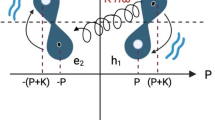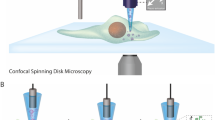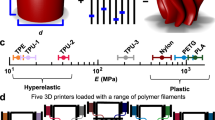Abstract
The self-assembly of supramolecular structures that are ordered on the nanometre scale is a key objective in nanotechnology. DNA1,2,3,4 and peptide5,6,7 nanotechnologies have produced various two- and three-dimensional structures, but protein molecules have been underexploited in this area of research. Here we show that the genetic fusion of subunits from protein assemblies that have matching rotational symmetry generates species that can self-assemble into well-ordered, pre-determined one- and two-dimensional arrays that are stabilized by extensive intermolecular interactions. This new class of supramolecular structure provides a way to manufacture biomaterials with diverse structural and functional properties.
This is a preview of subscription content, access via your institution
Access options
Subscribe to this journal
Receive 12 print issues and online access
$259.00 per year
only $21.58 per issue
Buy this article
- Purchase on Springer Link
- Instant access to full article PDF
Prices may be subject to local taxes which are calculated during checkout



Similar content being viewed by others
References
Rothemund, P. W. K. Folding DNA to create nanoscale shapes and patterns. Nature 440, 297–302 (2006).
Douglas, S. M. et al. Self-assembly of DNA into nanoscale three-dimensional shapes. Nature 459, 414–418 (2009).
Winfree, E., Liu, F. R., Wenzler, L. A. & Seeman, N. C. Design and self-assembly of two-dimensional DNA crystals. Nature 394, 539–544 (1998).
Zheng, J. et al. From molecular to macroscopic via the rational design of a self-assembled 3D DNA crystal. Nature 461, 74–77 (2009).
Rajagopal, K. & Schneider, J. P. Self-assembling peptides and proteins for nanotechnological applications. Curr. Opin. Struct. Biol. 14, 480–486 (2004).
Colombo, G., Soto, P. & Gazit, E. Peptide self-assembly at the nanoscale: a challenging target for computational and experimental biotechnology. Trends Biotechnol. 25, 211–218 (2007).
Woolfson, D. N. & Mahmoud, Z. N. More than just bare scaffolds: towards multi-component and decorated fibrous biomaterials. Chem. Soc. Rev. 39, 3464–3479 (2010).
Zhang, S. Fabrication of novel biomaterials through molecular self-assembly. Nature Biotechnol. 21, 1171–1178 (2003).
Moll, D. et al. S-layer-streptavidin fusion proteins as template for nanopatterned molecular arrays. Proc. Natl Acad. Sci. USA 99, 14646–14651 (2002).
Sleytr, U. B., Egelseer, E. M., Ilk, N., Pum, D. & Schuster, B. S-Layers as a basic building block in a molecular construction kit. FEBS J. 274, 323–334 (2007).
Ringler, P. & Schulz, G. E. Self-assembly of proteins into designed networks. Science 302, 106–109 (2003).
Dotan, N., Arad, D., Frolow, F. & Freeman, A. Self-assembly of a tetrahedral lectin into predesigned diamondlike protein crystals. Angew. Chem. Int. Ed. 38, 2363–2366 (1999).
Chau, T. F. et al. Enzyme nanorings. ACS Nano 2, 2519–2525 (2008).
Padilla, J. E., Colovos, C. & Yeates, T. O. Nanohedra: using symmetry to design self assembling protein cages, layers, crystals, and filaments. Proc. Natl Acad. Sci. USA 98, 2217–2221 (2001).
Schmidt, T. G., Koepke, J., Frank, R. & Skerra, A. Molecular interaction between the Strep-tag affinity peptide and its cognate target, streptavidin. J. Mol. Biol. 255, 753–766 (1996).
Fairman, R. et al. Design of heterotetrameric coiled coils: evidence for increased stabilization by Glu(–)–Lys(+) ion pair interactions. Biochemistry 35, 2824–2829 (1996).
Yan, H., Park, S. H., Finkelstein, G., Reif, J. H. & LaBean, T. H. DNA-templated self-assembly of protein arrays and highly conductive nanowires. Science 301, 1882–1884 (2003).
Dieluweit, S., Pum, D. & Sleytr, U. Formation of a gold superlattice on an S-layer with square lattice symmetry. Supramol. Sci. 5, 15–19 (1998).
Pleschberger, M. et al. An S-layer heavy chain camel antibody fusion protein for generation of a nanopatterned sensing layer to detect the prostate-specific antigen by surface plasmon resonance technology. Bioconj. Chem. 15, 664–671 (2004).
Selmi, D. N. et al. DNA-templated protein arrays for single-molecule imaging. Nano Lett. 11, 657–660 (2011).
Gipson, B., Zeng, X., Zhang, Z. Y. & Stahlberg, H. 2dx—user-friendly image processing for 2D crystals. J. Struct. Biol. 157, 64–72 (2007).
Crowther, R. A., Henderson, R. & Smith, J. M. MRC image processing programs. J. Struct. Biol. 116, 9–16 (1996).
Acknowledgements
The authors thank R. Owen for AFM imaging, E. Valkov, R. Gilbert and members of the LMB, Oxford, for discussions, I. Sinclair for critical reading of the manuscript, and I. Taylor for technical support. The authors are also grateful to Oxford University and Crysalin Ltd for financial support.
Author information
Authors and Affiliations
Contributions
J.C.S. proposed the original design principle and performed bioinformatics analysis, molecular modelling, cloning of expression constructs, protein production and biophysical characterization, as well as assisting in recording and analysing electron micrographs. K.M.D. recorded the presented electron micrographs and carried out initial image analysis. C.V-B. managed the EM facility and supervised K.M.D. in her contribution. M.E.M.N. worked with J.C.S. to develop the original design, advised on the direction of the research and performed the image analysis presented in Fig. 3. J.C.S. and M.E.M.N. prepared the manuscript with critical comment from all authors.
Corresponding authors
Ethics declarations
Competing interests
The authors declare no competing financial interests.
Supplementary information
Supplementary information
Supplementary information (PDF 1548 kb)
Rights and permissions
About this article
Cite this article
Sinclair, J., Davies, K., Vénien-Bryan, C. et al. Generation of protein lattices by fusing proteins with matching rotational symmetry. Nature Nanotech 6, 558–562 (2011). https://doi.org/10.1038/nnano.2011.122
Received:
Accepted:
Published:
Issue Date:
DOI: https://doi.org/10.1038/nnano.2011.122
This article is cited by
-
Design of supramolecular nanosheets for drug delivery applications
Polymer Journal (2023)
-
Supramolecular assembling systems of hemoproteins using chemical modifications
Journal of Inclusion Phenomena and Macrocyclic Chemistry (2023)
-
Complete and cooperative in vitro assembly of computationally designed self-assembling protein nanomaterials
Nature Communications (2021)
-
Protein interface redesign facilitates the transformation of nanocage building blocks to 1D and 2D nanomaterials
Nature Communications (2021)
-
Design of metal-mediated protein assemblies via hydroxamic acid functionalities
Nature Protocols (2021)



